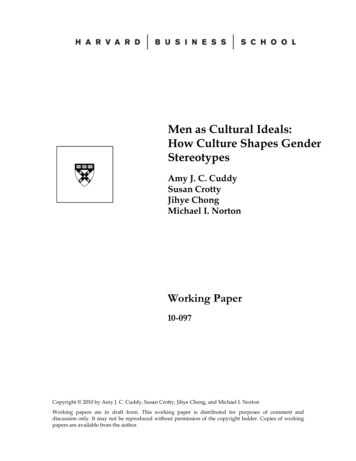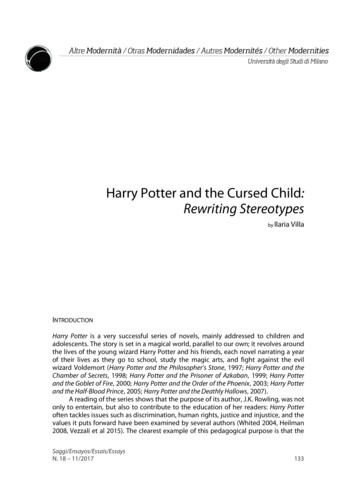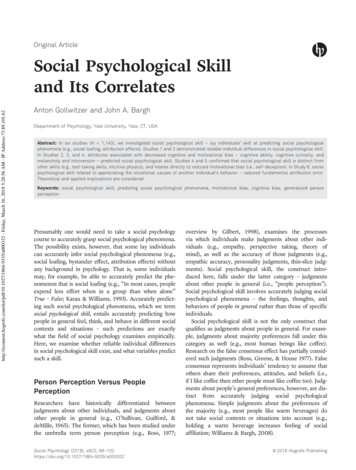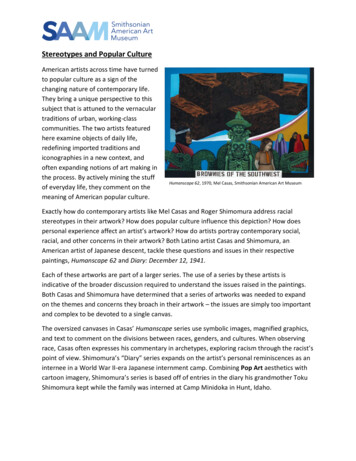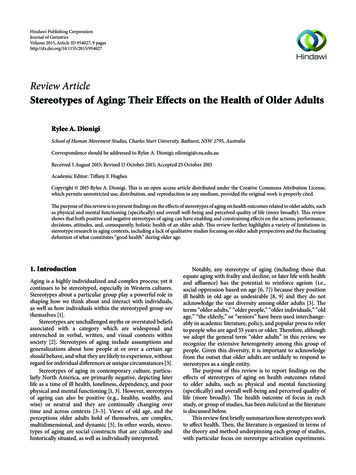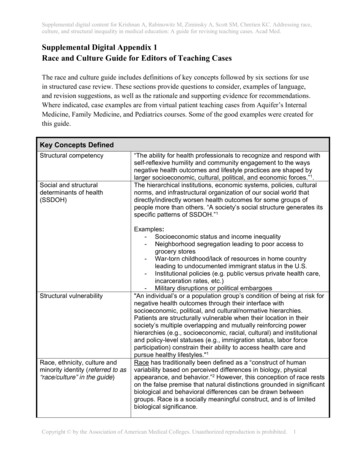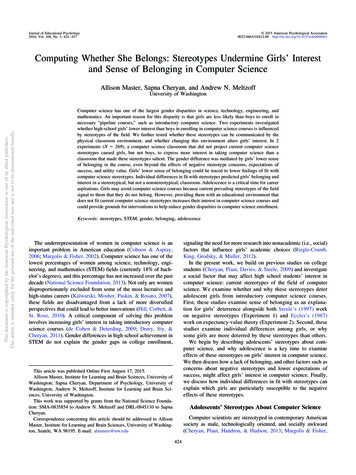
Transcription
Journal of Educational Psychology2016, Vol. 108, No. 3, 424 – 437 2015 American Psychological Association0022-0663/16/ 12.00 http://dx.doi.org/10.1037/edu0000061Computing Whether She Belongs: Stereotypes Undermine Girls’ Interestand Sense of Belonging in Computer ScienceAllison Master, Sapna Cheryan, and Andrew N. MeltzoffThis document is copyrighted by the American Psychological Association or one of its allied publishers.This article is intended solely for the personal use of the individual user and is not to be disseminated broadly.University of WashingtonComputer science has one of the largest gender disparities in science, technology, engineering, andmathematics. An important reason for this disparity is that girls are less likely than boys to enroll innecessary “pipeline courses,” such as introductory computer science. Two experiments investigatedwhether high-school girls’ lower interest than boys in enrolling in computer science courses is influencedby stereotypes of the field. We further tested whether these stereotypes can be communicated by thephysical classroom environment, and whether changing this environment alters girls’ interest. In 2experiments (N 269), a computer science classroom that did not project current computer sciencestereotypes caused girls, but not boys, to express more interest in taking computer science than aclassroom that made these stereotypes salient. The gender difference was mediated by girls’ lower senseof belonging in the course, even beyond the effects of negative stereotype concerns, expectations ofsuccess, and utility value. Girls’ lower sense of belonging could be traced to lower feelings of fit withcomputer science stereotypes. Individual differences in fit with stereotypes predicted girls’ belonging andinterest in a stereotypical, but not a nonstereotypical, classroom. Adolescence is a critical time for careeraspirations. Girls may avoid computer science courses because current prevailing stereotypes of the fieldsignal to them that they do not belong. However, providing them with an educational environment thatdoes not fit current computer science stereotypes increases their interest in computer science courses andcould provide grounds for interventions to help reduce gender disparities in computer science enrollment.Keywords: stereotypes, STEM, gender, belonging, adolescencesignaling the need for more research into nonacademic (i.e., social)factors that influence girls’ academic choices (Riegle-Crumb,King, Grodsky, & Muller, 2012).In the present work, we build on previous studies on collegestudents (Cheryan, Plaut, Davies, & Steele, 2009) and investigatea social factor that may affect high school students’ interest incomputer science: current stereotypes of the field of computerscience. We examine whether and why these stereotypes deteradolescent girls from introductory computer science courses.First, these studies examine sense of belonging as an explanation for girls’ deterrence alongside both Steele’s (1997) workon negative stereotypes (Experiment 1) and Eccles’s (1987)work on expectancy-value theory (Experiment 2). Second, thesestudies examine individual differences among girls, or whysome girls are more deterred by these stereotypes than others.We begin by describing adolescents’ stereotypes about computer science, and why adolescence is a key time to examineeffects of these stereotypes on girls’ interest in computer science.We then discuss how a lack of belonging, and other factors such asconcerns about negative stereotypes and lower expectations ofsuccess, might affect girls’ interest in computer science. Finally,we discuss how individual differences in fit with stereotypes canexplain which girls are particularly susceptible to the negativeeffects of these stereotypes.The underrepresentation of women in computer science is animportant problem in American education (Cohoon & Aspray,2006; Margolis & Fisher, 2002). Computer science has one of thelowest percentages of women among science, technology, engineering, and mathematics (STEM) fields (currently 18% of bachelor’s degrees), and this percentage has not increased over the pastdecade (National Science Foundation, 2013). Not only are womendisproportionately excluded from some of the most lucrative andhigh-status careers (Kalwarski, Mosher, Paskin, & Rosato, 2007),these fields are disadvantaged from a lack of more diversifiedperspectives that could lead to better innovations (Hill, Corbett, &St. Rose, 2010). A critical component of solving this probleminvolves increasing girls’ interest in taking introductory computerscience courses (de Cohen & Deterding, 2009; Drury, Siy, &Cheryan, 2011). Gender differences in high school achievement inSTEM do not explain the gender gaps in college enrollment,This article was published Online First August 17, 2015.Allison Master, Institute for Learning and Brain Sciences, University ofWashington; Sapna Cheryan, Department of Psychology, University ofWashington; Andrew N. Meltzoff, Institute for Learning and Brain Sciences, University of Washington.This work was supported by grants from the National Science Foundation: SMA-0835854 to Andrew N. Meltzoff and DRL-0845110 to SapnaCheryan.Correspondence concerning this article should be addressed to AllisonMaster, Institute for Learning and Brain Sciences, University of Washington, Seattle, WA 98195. E-mail: almaster@uw.eduAdolescents’ Stereotypes About Computer ScienceComputer scientists are stereotyped in contemporary Americansociety as male, technologically oriented, and socially awkward(Cheryan, Plaut, Handron, & Hudson, 2013; Margolis & Fisher,424
This document is copyrighted by the American Psychological Association or one of its allied publishers.This article is intended solely for the personal use of the individual user and is not to be disseminated broadly.STEREOTYPES AND GIRLS’ INTEREST IN COMPUTER SCIENCE2002). Other stereotypes about the culture of computer scienceinclude a perception that it requires “brilliance” (Leslie, Cimpian,Meyer, & Freeland, 2015), and is isolating and does not involvecommunal goals such as helping or working with others (Diekman,Brown, Johnston, & Clark, 2010). These stereotypes can be transmitted by the media, role models, and academic environments (fora review, see Cheryan, Master, & Meltzoff, 2015). In this article,we focus on academic environments for three reasons. First, manipulating classroom environment provides a way to test howcommonly held stereotypes of academic fields influence adolescents. Second, students spend significant time in academic environments such as classrooms, hallways, computer labs, and teachers’ workspaces, and the design of these spaces may influencehigh-school students’ interest in pursuing certain fields of study.Third, classroom environments may be a more practical target forchange on the part of individual schools and teachers, comparedwith media or role models.Previous studies with college students reveal that making stereotypes of the field salient in an academic environment decreaseswomen’s interest in computer science (Cheryan et al., 2009). Forexample, college women who entered a computer science classroom that included objects stereotypically associated with computer science (e.g., science fiction posters, stray electronic parts)reported less interest in computer science than women who enteredthe same classroom containing objects that were not stereotypically associated with computer science (e.g., art posters, generalinterest books; Cheryan et al., 2009). In contrast, the classroomenvironment did not affect men’s interest (see also Cheryan, Meltzoff, & Kim, 2011).Most previous research on stereotypes about the field ofcomputer science has been conducted with college students.However, adolescence is a particularly important age to examine for both theoretical and practical reasons. In terms of theory,adolescence is a critical time for identity formation. Middleadolescence (ages 14 –15) is when opposing self-attributes begin to bother students and remain a source of internal conflict,particularly for girls (Harter, 1990). In terms of practice,younger students are starting to make critical career choices(Weisgram & Bigler, 2006), and are at a key age in which tointervene to decrease gender disparities in STEM (Lupart &Cannon, 2002). Because the decision to forgo even one feedercourse can effectively prevent students from majoring in STEM(Moses, Howe, & Niesz, 1999), investigating factors that encourage girls to enter introductory “pipeline” courses is crucial.Girls’ sense of “belonging” in an academic environment mayhave a particularly strong influence on their interest.425type of person that belongs in that environment, but the studentdoes not see herself (or himself) as that type of person, then thiscreates a “mismatch” between person and environment. The morethat people perceive a mismatch between the academic environment and their own identity, the less likely they are to feel that theybelong there (Cheryan et al., 2009; Stephens, Fryberg, Markus,Johnson, & Covarrubias, 2012). Because computer science stereotypes are more compatible with the male gender role than thefemale gender role (Cheryan, 2012), girls are less likely to feel asense of personal fit with these stereotypes. Fit with stereotypes isthe extent to which there is a match between one’s own characteristics and prevailing cultural stereotypes of the field. In turn, thisreduced feeling of fit with stereotypes means that girls may feelless belonging in a classroom containing stereotypical objects thantheir male peers. In contrast, showing girls a classroom environment that counteracts prevailing stereotypes should remove thatbarrier and increase feelings of belonging.Belonging is thought to be a fundamental human motivation,and lack of belonging can lead to negative effects on academicmotivation and sense of well-being (Baumeister & Leary, 1995).Though the effects of belonging on interest should be evidentbroadly (among both girls and boys and across different careerdomains), sense of belonging in STEM has been shown to be aparticularly strong predictor of women’s STEM interest and motivation (Good, Rattan, & Dweck, 2012; Smith, Lewis, Hawthorne,& Hodges, 2013). Indeed, stereotypes associating STEM fieldswith males may make girls vigilant for cues about their belongingin STEM-related situations (Cohen & Garcia, 2008). When thecues reinforce stereotypes and signal that girls may not belonggirls may have less interest than boys in entering that situation, asshown in Figure 1. For example, women who watched a videofeaturing a STEM conference in which women were underrepresented showed increased physiological and cognitive arousal andfelt less belonging compared to women who watched a video withbalanced representation; they were also less interested in attendingthe conference (Murphy, Steele, & Gross, 2007).Beyond Belonging: Other Factors That Shape InterestOther factors also play a role in explaining effects of academicstereotypes on girls’ interest, such as expectations of success,utility value, and stereotype threat. Currently, girls report lowerEffects of Computer Science Stereotypes on BelongingBelonging in an academic environment refers to students’ sensethat they would fit in with the people, materials, and activitieswithin that environment (Cheryan et al., 2009). The physicalobjects in an environment serve as cues about who belongs there.Objects are powerful because they can signal the culture of thepeople associated with that environment (Cheryan et al., 2009).When entering an environment for the first time, people interpretthe cues in that environment for messages about whether theybelong there (Murphy et al., 2007; Schmitt, Davies, Hung, &Wright, 2010). If the objects in a classroom environment signal theFigure 1. Theoretical model indicating how stereotypes about computerscience affect girls’ interest in enrolling in computer science courses. Whencomputer science stereotypes are salient, girls feel a lower fit with stereotypes than boys, which decreases girls’ belonging, thereby decreasing girls’interest in enrolling in computer science courses. The empirical datareported in this article indicate that the belonging mediation held whencontrolling for negative stereotype concerns, expectations of success, andutility value.
This document is copyrighted by the American Psychological Association or one of its allied publishers.This article is intended solely for the personal use of the individual user and is not to be disseminated broadly.426MASTER, CHERYAN, AND MELTZOFFself-efficacy than boys in STEM (Pajares, 2005), and some research has found that some girls place less value on the utility ofmath and physical science (Chow, Eccles, & Salmela-Aro, 2012).Both expectations of success and utility value predict enrollmentinterest, although utility value may be a stronger predictor ofchoices than expectations of success (Parsons, Adler, & Meece,1984). Cultural stereotypes about occupational fields can affecthow much those fields are valued (Eccles, 2011; Eccles et al.,1983), with girls being more likely to value fields stereotyped asappropriate for their gender. However, it is unclear whether changing academic stereotypes would affect girls’ expectations of success or utility value.Stereotype threat—students’ concerns about being judgedthrough the lens of a negative stereotype about their ability(Steele, 1997)—may be another important predictor of girls’interest in STEM (Thoman, Smith, Brown, Chase, & Lee,2013). Negative stereotypes about girls’ lower ability in STEMcan harm their performance (Huguet & Régner, 2007), whichmay deter girls from choosing to pursue STEM (Davies, Spencer, Quinn, & Gerhardstein, 2002). Stereotype threat can reducewomen’s feelings of belonging in STEM (Murphy et al., 2007;Smith et al., 2013) and has a negative impact on students’expectations of success (Smith et al., 2013; Walton & Cohen,2007). A stereotypical environment could increase girls’ concerns about negative gender stereotypes, thus decreasing theirinterest.This article adds to the literature by directly comparingbelonging, expectations of success, utility value, and stereotypethreat (across two experiments), to examine their relative powerin predicting girls’ lower interest in computer science comparedwith boys when stereotypes are salient. We predict that belonging will have a particularly strong influence on interest becausebelonging is a fundamentally important motivator (Baumeister& Leary, 1995). We also examine a potentially important individual difference that may affect belonging—whether studentsfeel that they personally fit the stereotype of a computer scientist.Individual Differences in Fit WithAcademic StereotypesAlthough lack of fit with prevailing stereotypes has been theorized to explain girls’ lack of interest in computer science(Cheryan, 2012), there has been no empirical examination ofwhether students who feel that they do not fit the stereotypes of thefield feel less belonging and interest in computer science when itis depicted stereotypically than students who feel a greater fit withthese stereotypes. We investigate effects of fit with stereotypes intwo ways. First, we expect that girls’ lower sense of belongingcompared to boys can be traced back to their lower sense of fitwith stereotypes. Second, when current stereotypes of the field aresalient, girls who feel that they do not fit these stereotypes shouldshow reduced belonging and interest in a computer science classcompared to girls who feel greater fit with stereotypes. However,when computer science stereotypes are not salient, girls’ feelingthat they do not fit computer science stereotypes should have lessimpact on their belonging and interest in a computer science class.The Present ResearchHow Academic Stereotypes Affect Adolescents’Interest and BelongingUnderstanding the factors that explain girls’ lower interest iscrucial to remedying current gender disparities in computer science (Ceci, Ginther, Kahn, & Williams, 2014). Interest is a critically important motivational variable because it can affect subsequent learning and performance (Hidi & Harackiewicz, 2000).Interest may develop through four levels: triggered situationalinterest (immediate and spontaneous engagement in a topic), maintained situational interest, emerging individual interest, and welldeveloped individual interest (Hidi & Renninger, 2006). Our useof enrollment interest is similar to triggered situational interest inthat we examine how factors in the immediate environment mayincrease interest in enrolling in a course. As enrollment interest isa powerful predictor of subsequent course enrollment (Eagan et al.,2013), actual course enrollment could then help to transformsituational interest into well-developed individual interest, whichis a more stable, dispositional interest in a particular domain(Harackiewicz, Durik, Barron, Linnenbrink-Garcia, & Tauer,2008). Creating environmental conditions that trigger situationalinterest is a critical part of the process of developing deep interestin a topic (Hidi & Renninger, 2006).Recently 10,000 schools across the United States requested helpin adding computer science to their curriculum (Dudley, 2013),and the White House has announced initiatives to support computer science education in K–12 schools (Office of the PressSecretary, 2014). It is critical to address these changes in educationin a scientific way. We experimentally examine how exposure tocomputer science stereotypes affects girls’ belonging and interestin enrolling in computer science courses. Based on the findings ofCheryan and colleagues (2009), we predict that nonstereotypicalclassroom environments will increase girls’ (but not boys’) interestin enrolling in a computer science course. We examine belongingas a mediator in Experiments 1 and 2, compared with concernsabout negative ability stereotypes (Experiment 1), expectations ofsuccess (Experiment 2), and utility value (Experiment 2). We alsoexamine gender differences in fit with current stereotypes of thefield, and whether fit with stereotypes predicts individual differences in girls’ belonging and interest (Experiment 1).Experiment 1: Effects of Classroom Environments onGirls’ Interest in Computer Science CoursesIn Experiment 1, we investigated effects of stereotypical andnonstereotypical classroom environments on high-school girls’interest in enrolling in introductory computer science courses.Critically, we approached this issue experimentally, to examinewhether counteracting stereotypes can cause girls’ enrollment interest to increase. We predicted that girls would be less interestedin enrolling in computer science courses when the classroomenvironment was stereotypical than when it was nonstereotypical.We included a premeasure to examine students’ feelings aboutcomputer science before they learned about the environment of theclassroom. This allowed us to assess whether it was the stereotypical or the nonstereotypical environment that influenced girls’interest. We also predicted that girls would feel lower belonging in
STEREOTYPES AND GIRLS’ INTEREST IN COMPUTER SCIENCEthe stereotypical classroom than boys, and a mediation analysiswould reveal that girls’ lower belonging mediated their lowerinterest in that course, more so than girls’ concerns that they wouldbe judged negatively in that environment because of gender stereotypes. We also included an individual difference variable, fitwith stereotypes about computer science, to examine whether lackof fit with stereotypes predicted girls’ lower belonging and interestin stereotypical settings.This document is copyrighted by the American Psychological Association or one of its allied publishers.This article is intended solely for the personal use of the individual user and is not to be disseminated broadly.MethodParticipants. Participants were 165 students at two highschools in the Northwestern United States. Fifty-four studentswere from a private school (26 young women, 27 young men; 1student did not provide gender; Mage 15.67 years, SD 0.91;age range: 14 –17 years; 6% did not provide this information) and111 were from a public school (51 young women, 55 young men;5 students did not provide gender; Mage 16.01 years, SD 1.20;age range: 14 –18 years; 13% did not provide this information).Students who did not provide gender were removed from analysesinvolving gender in both experiments. At the private school, 36%were freshmen, 32% were sophomores, and 32% were juniors (2%did not provide this information). Private school participants were72% White, 2% Latino/a, 7% Asian/Pacific Islander, 11% multipleethnicities, 4% Black, and 2% other (2% did not provide thisinformation). At the public school, 47% were freshmen, 14% weresophomores, 20% were juniors, and 14% were seniors (5% did notprovide this information). Public school participants were 29%White, 29% Latino/a, 24% Asian/Pacific Islander, 8% multipleethnicities, 3% Black, and 3% other (5% did not provide thisinformation). At the private school, 17% of students typicallyreceived need-based financial aid; at the public school, 65% of allstudents were typically eligible for free or reduced lunch.Each student participated in only one experiment. Analyses showedthat school did not significantly interact with gender or classroomenvironment on any of our dependent measures, Fs 2.91, ps .08, p2s .023, so we combined the school samples. Intraclass Correlations (ICCs) revealed that the proportion of variance in enrollmentinterest that was because of participants’ actual classroom was negligible for all three measurements of interest (ICCpremeasure .004;ICCstereotypical .03; ICCnonstereotypical .04).Students were recruited by using an opt-out information letter toparents, allowing for a high participation rate (at the public school, 85% of eligible students participated across Experiments 1–2;the remaining students either opted-out with the letter, did notassent, or were absent). No parents at the private school opted out,although a few students declined to assent to participate. Studentswho assented to participate completed a survey during their gradelevel meeting time (at the private school) or during their math class(at the public school).We also asked participants how many computer science classesthey had taken previously, M 0.50, SD 0.94. There was nodifference between male and female participants in this study,t(152) 0.09, p .93, d 0.01.Materials. This experiment utilized methodology used in previous research with adults (Cheryan et al., 2009). We manipulatedclassroom environments using two photographs created for this experiment. In designing these photographs, we decorated a small university classroom (i.e., 12 desks) using objects either identified as427stereotypical or nonstereotypical of computer science in previousresearch. The stereotypical objects were Star Wars/Star Trek items,electronics, software, tech magazines, computer parts, video games,computer books, and science fiction books. The nonstereotypicalobjects were nature pictures, art pictures, water bottles, pens, a coffeemaker, lamps, general magazines, and plants. Both classrooms alsocontained a table and chair at the front of the room, desks for students,a side table, and a storage unit in the corner.To examine whether adolescent students associated the stereotypical objects with computer science more than the nonstereotypical objects, we conducted a pilot survey with a separate groupof high school students (N 106; 54 male, 50 female, twounidentified), who were given a list of these items and asked to ratehow much they associated each object with computer science on7-point scales (1 not at all and 7 extremely). Ratings for thestereotypical and nonstereotypical objects were averaged into separate composites. We assessed internal consistency using Cronbach’s , which indicated acceptable reliability (e.g., Clark &Watson, 1995) for both sets of objects: stereotypical: .74;nonstereotypical: .86. A 2 2 (Object Type Gender)mixed-model analysis of variance (ANOVA) showed that thestereotypical objects were rated as significantly more stereotypicalof computer science than the nonstereotypical objects (stereotypical: M 5.28, SD 0.88; nonstereotypical: M 2.51, SD 1.07), F(1, 101) 498.15, p .001, d 2.22. There was no maineffect of gender, F(1, 101) 0.29, p .59, d 0.11, and nointeraction between object type and participant gender, F(1,101) 1, p .34, p2 .009, indicating that both girls and boysassociated the stereotypical objects more strongly with computerscience than the nonstereotypical objects.Procedure. Participants read an introduction stating, “We areinterested in your thoughts about different potential classes youcould take in high school. You will see different classrooms to getan idea of what they look like, and then you will be asked for yourthoughts on those classes.” Before they were told about the classrooms, participants first answered a series of premeasure questionsincluding two items assessing their interest in enrolling in a potential high-school “Introduction to Computer Science” course,four items assessing feelings of belonging in this course, and fouritems assessing concerns about negative stereotypes in this course(see “Dependent measures” section below for items).Participants then read, “Next, you will be looking at two classrooms that are being used to teach this course: Classroom A andClassroom B. Even if you are not sure you would take a computerscience class, please give us your opinion about your preferencefor one classroom over the other.” They were given more information about the two computer science courses (including photosof the two classrooms), and then answered the same questionsabout interest in enrolling, belonging, and concerns about negativestereotypes specifically for each course (see items below).The information stated that both courses covered the samematerial (computer science) and were identical in terms of amountof homework, teacher gender (male), and gender proportion ofstudents (50% male, 50% female). These were controlled to examine the effect of stereotypes above and beyond other assumptions they evoked, such as gender proportion or amount of homework. Participants then saw photos of the two classrooms.Classroom environment was thus manipulated within-subjects.The order of photos (and the order in which participants evaluated
This document is copyrighted by the American Psychological Association or one of its allied publishers.This article is intended solely for the personal use of the individual user and is not to be disseminated broadly.428MASTER, CHERYAN, AND MELTZOFFeach classroom for all of the dependent measures) was counterbalanced; there were no main effects or interactions of order onenrollment interest or belonging, Fs 0.58, ps .45, ds 0.09.There was a main effect of order on negative stereotype concerns,F(1, 141) 7.48, p .007, d 0.31, with participants expressinggreater negative stereotype concerns overall when they rated thestereotypical classroom first (M 2.53, SD 1.30 vs. M 2.15,SD 1.15), but this did not interact with gender, F(1, 141) 0.09,p .76, p2 .001, or classroom environment, F(1, 141) 0.11,p .74, p2 .001.Dependent measures.Attention check. We included five multiple-choice attentionchecks, including number of courses (two), student gender (equalnumbers of males and females), teacher gender (both male), topic(computer science), and amount of homework (same). Overall,91% of participants passed the number of courses question; 93%passed the teacher gender and course topic questions; and 97%passed the homework and student gender questions.Choice. Students were asked to choose which of the twocourses they would take.Enrollment interest. Two items assessing students’ interest inenrolling in each course were averaged to create the measure ofenrollment interest (see Cheryan, Meltzoff, et al., 2011 for previous reliability and validity of scale). Students rated how much theywould want to take this class, and how likely they were to choosethis class (1 not at all and 7 extremely). Reliability of theseitems was high for both classrooms (stereotypical classroom: .92; nonstereotypical classroom: .92).Belonging. Four items were averaged to assess how muchstudents felt that they belonged in this class (see Cheryan et al.,2009 for previous reliability and validity of scale). Students ratedhow similar they were to the students who take this class, howmuch they thought they belonged in this class, how well theywould fit in the general environment of this class, and how wellthey would fit in with the students in this class (1 not at all and7 extremely). Reliability was high for both classrooms (stereotypical classroom: .94; nonstereotypical classroom: .92).Negative stereotype concerns. We measured negative stereotype concerns by averaging four items (see Cohen & Garcia, 2005;Marx, Stapel, & Muller, 2005 for previous reliability and validityof scale items). Students rated how much they would worry thattheir ability to do well in the course would be affected by theirgender, how anxious they would be about confirming a negativestereotype about their gender, how much they would worry thatothers would draw conclusions about their gender based on theirperformance, and how much they would worry that others woulddraw conclusions about them based on their gender (1 not at alland 7 extremely; stereotypical classroom: .88; nonstereotypical classroom: .87).Fit with stereotypes. To explore whether individual differences in girls’ perceived fit with the stereotypes of computerscientists predicted their enrollment interest and belonging, wealso asked participants, “How much
tion for girls' deterrence alongside both Steele's (1997) work on negative stereotypes (Experiment 1) and Eccles's (1987) work on expectancy-value theory (Experiment 2). Second, these studies examine individual differences among girls, or why some girls are more deterred by these stereotypes than others.

